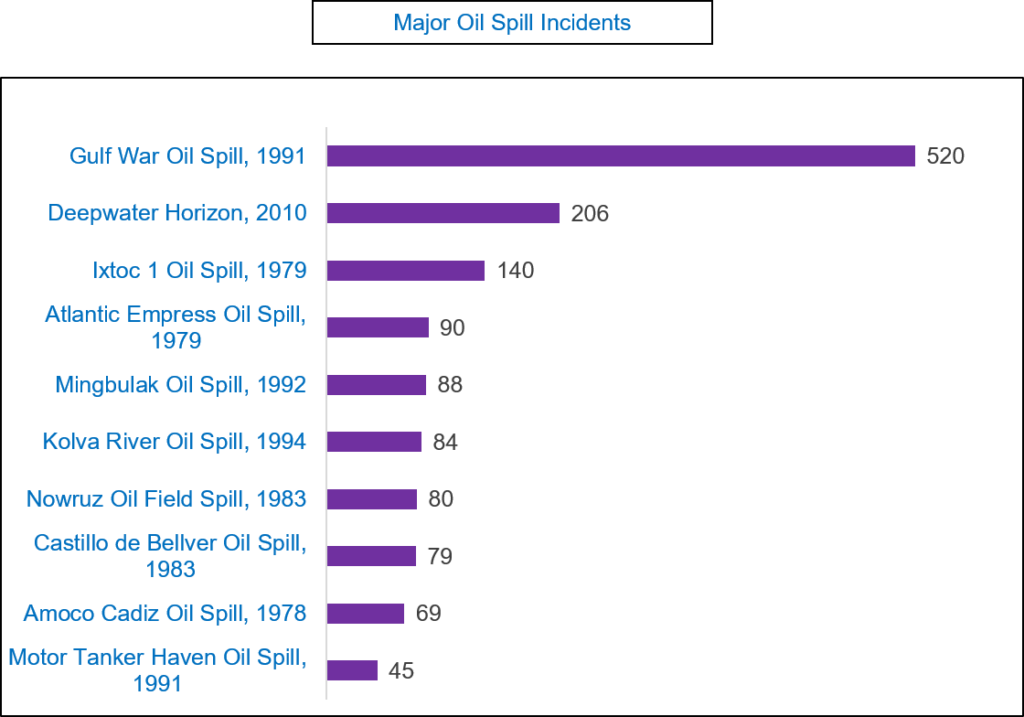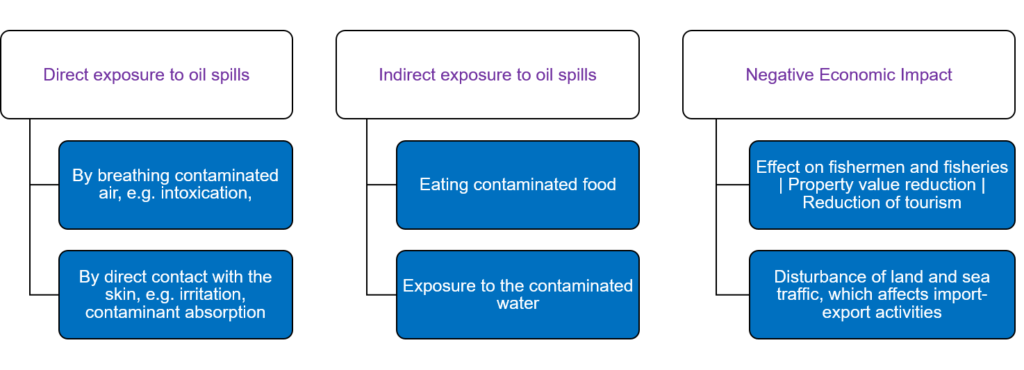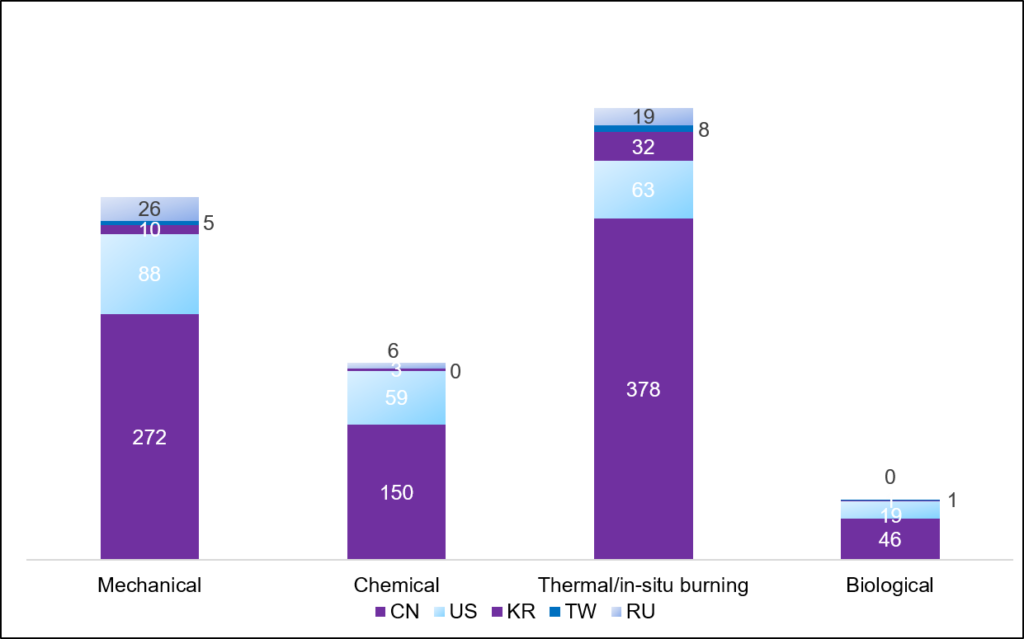Oil spills have been recorded as a serious environmental threat. Increased deep-sea oil production and exploration and oil transportation over the seas are the major reasons for oil spillage. Spilled oil must be removed from the water or the surface to protect the water and the environment. Marine oil combat is carried out to protect the environment and marine life, depending on the response after the oil spill. Thus, the demand for marine oil spill clean-up technologies is rising globally.
What is a Marine Oil Spill?
Marine oil spills include the leakage of crude oil or oil-distilled products (Gasoline, Diesel, Kerosene, etc.) onto the surface of a large water body. They can happen during exploration, production, or transportation.

Figure 1: Major oil spills (in million gallons)
Statistics show that since 1967, there have been numerous oil spills around the globe. Most of them were catastrophic, with significant ecological, economic, and social losses. For example, the Murphy oil spill (USA, 2001) contaminated flood waters with more than 1 million gallons of crude oil, directly affecting 1700 homes in several residential neighborhoods. The Deepwater Horizon oil spill (USA 2010) resulted in an oil spill of around 200 million gallons. The exposure to the oil spills can be either via direct or indirect means:

Figure 2: Types of exposure to oil spillage
Effects of Oil Spill
Oil spills have devastating effects on the surrounding ecosystem. They can be fatal for plant, animal, and human life. The toxicity of oil can cause massive loss of species that live in the water body:
- Effect on Plants: Oil spills greatly hamper the growth of aquatic plants. The thick layer of oil on the surface of water cuts off the air supply and sunlight. Without sunlight, plants can’t carry out photosynthesis and make food. Without food, the plants fail to germinate, and their growth stops.
- Effect on Wildlife: The oil spill affects the animals living in the water or near the shoreline. Oil penetrates the feathers of birds, making flying impossible and destroying natural insulation and waterproofing properties. Eventually, birds die due to poisoning, hypothermia, and multiple organ failure. When marine animals come in contact with oil-mixed water, adult fish may experience reduced growth, enlarged liver, heart, and respiration rate change, fin erosion, and reproduction impairment.
- Effect on Humans: The contamination of the local ecosystem can impact communities that rely on it for food and income. Fishermen and local people face critical health issues with exposure to oil, which affects their income.
Marine Oil Spill Clean-up Methods
1. Mechanical Methods:
Mechanical methods include physical barriers and mechanical devices to redirect and remove oil from the water surface. This method is quite feasible and effective and is preferred over other methods. However, it is affected by wind waves and currents. Mechanical solutions include booms, skimmers, and sorbents.
Booms: This is the most common method of clean-up; it involves using large floating booms with skirts extending into the water to isolate the spill area.
Skimmers: These machines scrape oil from the water surface. They first concentrate the oil and later skim it efficiently.
Sorbents: Sorbents recover oil through absorption &/or adsorption mechanism; materials such as peat moss, straw, hay, and sawdust are used to absorb the oil.
A detailed comparative overview of these methods is provided in the table mentioned below-
| Method | Advantage | Challenges | Maximum Efficiency | Application |
| Sorbents | Oil is recovered to avoid wastage | Sorbents absorb oil which makes it heavier and then difficult for organisms | 90% | Most effective in small oil spills or leftover traces of a larger spill |
| Skimming | Oil is recovered without any change in physical or chemical properties | Surface conditions affect the skimming process and reduce the efficiency | 95% | At less water movement |
| Booming | Non-corrosive, light weight, occupies little space | Stability reduces in different wind conditions | – | To remove oil from one spot which has a large area |
2. Chemical Methods
Dispersants: Dispersants have detergents-like action; they break up an oil slick into very small droplets, which dilute throughout the water. These smaller oil particles are more easily biodegraded and thus protect sensitive habitats threatened by a surface slick. Notably, dispersants do not remove the spilled oil.
Solidifiers: The solidifiers have a porous matrix and are high molecular weight polymers with large oleophilic surface area. These form a physical bond with the oil and raise oil viscosity to the point that the oil becomes solidified into a rubberlike solid. A detailed comparative overview of these methods is provided in the table mentioned below-
| Method | Advantage | Challenges | Maximum Efficiency | Application |
| Dispersants | It is a cost-effective technique that helps break up oil spills and prevents habitats from being exposed. This requires less man power | Poisoning fish, corals, and other marine species | 90% | When the spilled oil cannot be stopped by booms and spreads over large areas; In rough seas, slowing emulsion formation; Speeding up natural biodegradation |
| Solidifiers | Oil spills are solidified or converted into semi-solids with less cost | Oil recovery not possible | – | Used in seas |
3. Thermal or In-situ Burning
In this method, freshly spilled oil is burned (controlled burning), usually while still floating on the water surface. This method helps to remove almost 98% of oil spills. However, the burning residue and associated fumes affect the air quality near the spill area. Typical applications include cleaning arctic or subarctic environments, high-thickness oil slicks, calm seawater, and oil slicks not located in vulnerable areas, equipment, or facilities.
4. Biological Methods:
Specific microorganisms like bacteria feed on spilled oil. Further, nutrients like nitrogen and phosphorus are also required to encourage the microorganism’s growth. The method is quite cost-effective and sustainable and does not require much manpower. However, it is very time-consuming. It is particularly suitable for areas close to the shoreline.
IP trends since 2005 for jurisdiction-wise innovation status (priority country) of clean-up technologies have been highlighted below, indicating a sharp technology innovation in China, followed by the USA.

Figure 3: Priority country distribution for the IP filing related to particular clean-up technology
Marine oil spills may be different, each with its own unique conditions and complexities. Oil spills may result from various incidents, such as platform blowouts and accidents involving tankers, barges, pipelines, refineries, drilling rigs, storage facilities, etc. Also, the location, time of year, duration, depth, environmental conditions, affected biomes, and available response resources may all vary significantly.
The selection of oil spill methods depends on various factors such as oil type, oil viscosity, quantity of oil spill, weather conditions, wind speed, current velocity, wave height, and sea state.
Factors to be considered while selecting appropriate oil spillage clean-up techniques:
- Characteristics of the oil
- Shore’s topography and composition
- Wind, waves, and currents
- Weathering condition
Next Generation Marine Oil Spill Clean-up Technologies
Several efforts have been made to examine new designs and construction materials to improve the performance of conventional oil spill treatment methods. A few next-generation clean-up techniques have been provided below.
Graphene-Based Technologies: Graphene oxide nanoribbons and integrated nanoporous graphene (NPG) include graphene-based membranes like graphene sponges, graphene-decorated meshes, graphene hydrogels, graphene aerogels, graphene foam, and graphene-coated cotton. Sponges and aerogels modified by graphene and reduced graphene oxide have effective oil-water separation owing to their superhydrophobic or superoleophobic properties.
Magnetic Nanostructures—Specially designed (OHM) sponges coated with magnetic nanostructures have a carbon-based surface that attracts oil. The sponges use a magnetic nanostructure coating to capture crude oil. They can absorb more than 30 times their weight and continue to retain oil even when exposed to wave action.
Magnetic, Iron-rich Soap—Soap is formed from the liquid surfactant containing dissolved iron, which the magnets can control. This magnetic surfactant in the solution can alter a solution’s ability to dissolve oils in water and then remove them from a system. This particular innovation, i.e., soap sensitive to a magnetic field, is very helpful for oil spill clean-up.
Innovative Bioremediation Technologies – Bioremediation of oil spills involves using living organisms or by-products of living organisms to cause the breakdown and further detoxification of dangerous contaminants (oil). Recently, the concept of nano-enhanced bioremediation came into the picture, in which nanoparticles are used as magnetic sorbents as well as emulsifiers. These nano-particles increase the bioavailability of the oil by giving microbes a surface (droplets) to which they can attach and facilitate proliferation. The oil-water interfacial area increases, resulting in increased oil degradation by microorganisms due to Emulsification.
Further, other innovative solutions include:
- Modified improved skimmers
- Hybrid booms
- Composite Sorbents
Oil Spill Detection Techniques
Monitoring and detection of the oil spill is a crucial part of contingency planning for oil spills. Precise detection of oil spills and prediction of their trajectory is beneficial in developing a clean-up plan. The major drawback of conventional oil spill monitoring techniques (Aerial and field investigation) is that they are expensive and slow to be identified.
| Detection Technology | Spatial Resolution | 24-h Operation Ability | False Positive Effect | Altitude | Weather Operation |
| Visible | High | No | Affected by elements such as seaweed, darker shoreline | Below or Above 500 m | Affected by cloudy and non-clear weather |
| IR | High | Yes | Affected by elements such as seaweed, darker shoreline | Below or Above 250 m | Affected by heavy fog and cloudy sky |
| NIR | High | Yes | Affected by elements such as seaweed, darker shoreline | Below or Above 250 m | Affected by heavy fog and cloudy sky |
| UV | High | No | Sun glint, wind sheen and seaweed cause lookalikes | Below or Above 250 m | Requires a clearer Atmosphere |
| Optical Satellite | Medium | Yes | Sun glint, wind sheen and seaweed cause lookalikes | 700–900 km | Affected by heavy cloud cover |
| Radar Sensor | High | Yes | Affected by elements such as seaweed, high waves, darker shoreline | Airborne (10–12 km) and Satellite(700–900 km) | Sun glint, wind sheen, and seaweed cause lookalikes |
Further, advanced machine learning, artificial intelligence, computational tools, and IoT have made these techniques more reliable and precise. For example, satellite-piloted aircraft or UAV-based remote sensing (RS) techniques have been used extensively in detecting and monitoring oil spills. Apart from that, some other niche techniques are also being used in the industry to monitor oil spills. These are:-
- Laser Radar
- Dual co-polarization (VV and HH) radars
- Spectral image techniques
- Synthetic Aperture Radar (SAR)
- Fiber-Optic Surface Plasmon Resonance Sensors
- High-performance 5G network with autonomous drones/ smart
- Cameras
Long-wave infrared (LWIR) cameras & polarization-based camera
A deep dive into the above-mentioned techniques can also pave the way to detect, monitor, and thus prevent oil spills.
Marine Oil Spill Clean-up: Conclusion
Efforts are ongoing to develop detection methods and clean-up technologies to save the oceans and marine life from the hazardous effects of spilled oil. However, the best solution is to prevent these spills from happening in the first place. Moreover, by leveraging and utilizing the next-generation marine oil spill clean-up technologies and improving spill detection techniques, companies, and businesses can expand their horizon and help solve a huge problem. For a sustainable future and to mitigate the perils related to oil spills, Stellarix Consultancy Services can aid organizations determined to protect coastal areas, oceans, and other water streams in many ways, including oil spill cleanup guidelines.